A Slightly Obsessed Movie Theme Special!
Swing And A Miss
“Batter Up!”, as in the waning days of September I’ll be swatting out a few infield flies courtesy of four of my favorite baseball flicks. I’m callin’ ‘em Fall Classics.
A little background: In the summer and fall of 1982 I was 5 years old and the Milwaukee Brewers had their first (and to date only–though hope springs eternal) Championship Season. “On first base, Cecil Cooper! On second, Jimmy Gantner! On third, Paul Molitor! And at shortstop… Robin Yount!” And lest I should neglect to mention my own personal favorite among these earthbound sportsgods, the gloriously handle-bar mustachioed relief pitcher, Rollie Fingers. (Lemme tell ya, folks, the crowd ROARED whenever that man and his mustache took the pitcher’s mound.)
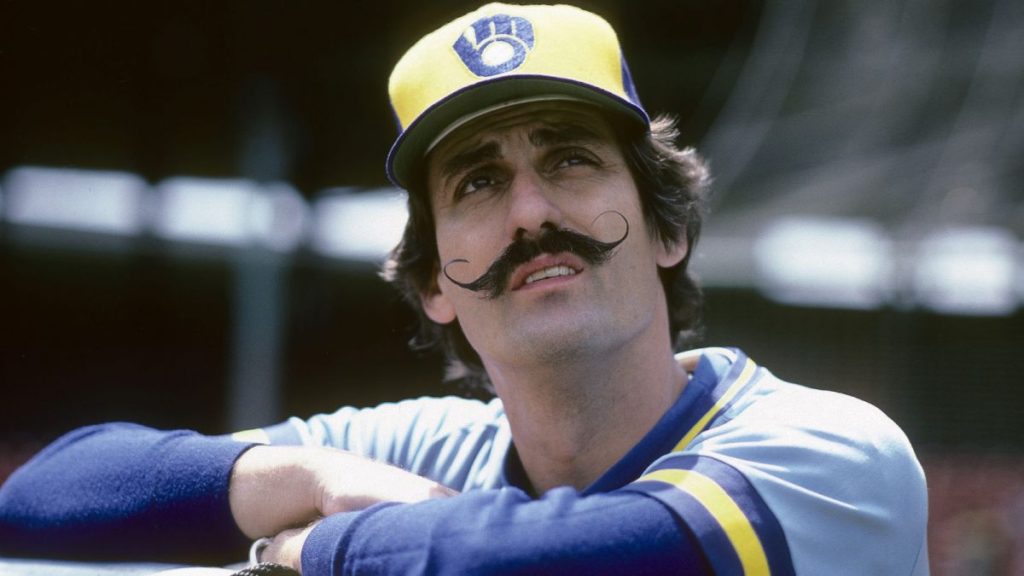
Rollie Fingers… and mustache
It was quite the line-up, and one of my prized possessions as a kid was a Topps WonderBread limited edition baseball card set—in a plain cardboard box, gifted to me and my siblings by our step-grandfather, who worked at Gardner’s Bakery—of every pennant-winning player on the Brewers roster, including manager Harvey Kuenn, for that fateful year. (Lost in one of my family’s many moves, alas!)
Yep, nothing beat my elation of following the Brewers’ Olympian triumphs that year, and nothing in my extreme youth compared to my bitter disappointment when they lost in the Series to the hated Cardinals. Maybe due to the latter point, I soon lost interest in baseball as a sport,–and discovered movies–but I nonetheless never missed a baseball movie when one came on TV or when one was released to the theaters.
Football, basketball, hockey, even track & field… There have been many good sports movies in the grand old Hollywood tradition, but I believe America’s Pastime has made for the very best in inspirational, come-from-behind, triumph-over-adversity, underdogging tales of athletic prowess and ritualized poetry-in-motion.
Also, for my plot descriptions this time out, I’ll get a chance to realize my secret dream of fake-writing a few sports articles…
I. THE PRIDE OF THE YANKEES
(1942, Samuel Goldwyn Co., dir. Sam Wood)
“Whaddya think of that one? Two home runs in one World Series game! He’s really a man, that man. From now on they’re gonna have to spell LOU GEHRIG’s name in capital letters.”
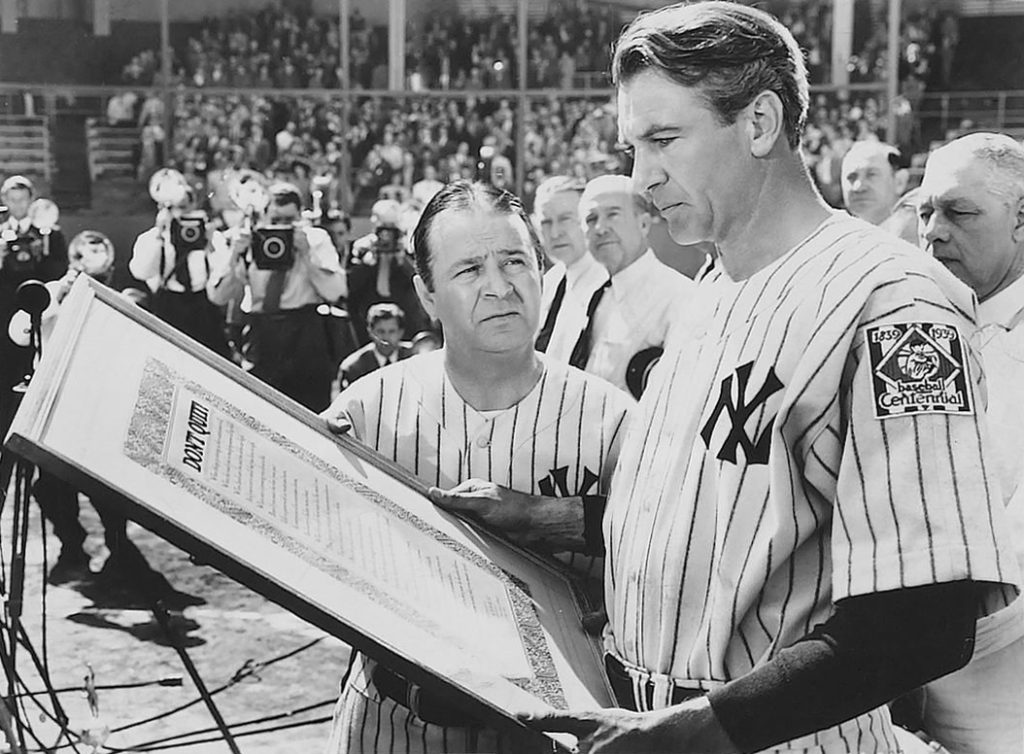
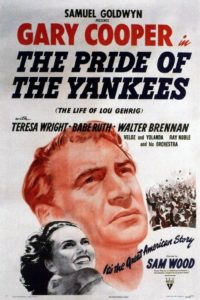 “New York Clarion”; September 7th 1927, Sam Blake (Walter Brennan) reporting…
“New York Clarion”; September 7th 1927, Sam Blake (Walter Brennan) reporting…
Murderers’ Row!
Bill Dickey, Mark Koenig, Bob Meusel (themselves), and The Sultan of Swat,—The King of Crash, The Colossus of Clout, The Great Bambino himself—George Herman Ruth (himself). Yes, sportsfans, the 1927 season is shaping up to be a true wonder as the Yanks continue to crush all comers. But there’s one name purposefully left out after this reporter witnessed a sterling act of unassuming compassion yesterday afternoon at New York County Hospital.
At a gala press event organized by our distinguished colleague at The Daily News, Hank Henneman (Dan Duryea), a plucky boy with a great love of baseball named Little “Billy” (Gene Collins), who faithfully listens to every Yankees game on a wireless next to his hospital bed, was promised a home-run in today’s match-up against Detroit by The Babe. After the last flashbulb fell, and The Babe had departed, who else but Lou Gehrig (Gary Cooper) should slowly and shyly sidle up to Little Billy’s bedside and strike up a conversation in which The Iron Horse promised the boy not one, but TWO home-runs in that very same game.
No crowds, no glaring lights, no scratchpads—except Yours Truly skulking ‘round the corner—Mr. Gehrig, a family man recently married to the former Miss Eleanor Twitchell (Teresa Wright) of Chicago, was just a nice guy talking to a good kid. You just wouldn’t have known the little man was talking to one of his heroes from the way Gehrig and him shot the breeze about school, friends, the outdoors–and of course baseball.
Look for it today, sportsfans, 1 p.m. at The House That Ruth Built, Yankee Stadium, in the Bronx. Yeah, Ruth mighta built it, but for this reporter’s money, Gehrig stands alone in it. He’s truly its Pride.
…
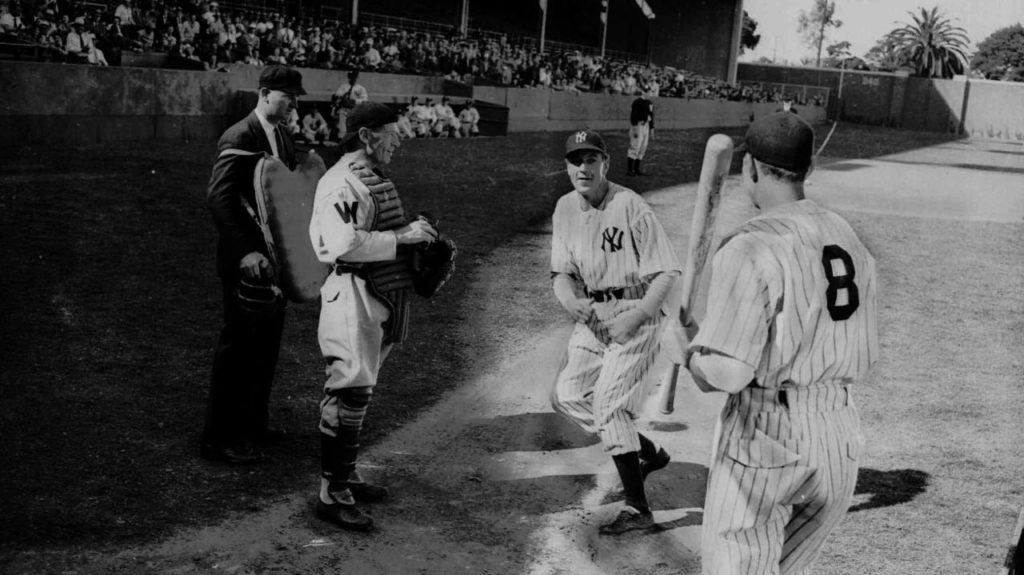
Samuel Goldwyn’s production of the biography of legendary New York Yankee’s first baseman, Lou Gehrig, is grand old syrupy schmaltz in the finest Hollywood tradition. And I don’t mean any disrespect in that, by the way, ‘cos if there’s one thing those bitter, cynical, hard-bitten producers, scribes, and film technicians of America’s Dream Factory excelled at it was in making grown men cry.
And what better point of attack than America’s Pastime? Here, Gary Cooper—twitchy and folksy in one of his better Aw, Shucks!-y put-on jobs—is ably abetted in baseball-ish bathos with a sentiment-dripping script by Jo Swerling & Herman J. Mankiewicz (the latter being one of the scriptwriters forCitizen Kane the year before), lusciously deep & soft-focus photography by Hungarian émigré, Rudolph Maté (who shot movies for Carl Theodor Dreyer before coming to Hollywood and becoming a great low-budget filmmaker), and expansive American Arena-like settings for Gehrig’s athletic triumphs—as recreated on Hollywood’s sound stages—by production designer, William Cameron Menzies (the much-celebrated set creator of Gone With the Wind and Things to Come, among many many others).
Yes, sportsfans, when producer Samuel Goldwyn (“Include me out.” “They stayed away in droves.”, among many other famous/infamous malapropisms) aimed for the fences, he usually succeeded in hitting one out of the park—mostly ‘cos he knew the right people to hire!
So yeah, in watching this one you might occasionally glance ever-so-slightly askance at the weird Oedipal drama enacted between Lou and his “Ma” (Ella Janssen), who only wants the best for her “little boy” (even if that means becoming an “engineer like [his] Uncle Otto” instead of the Yankee PowerHouse Hitter he’s *destined* to become), or the non-romance romance between chaste Lou and a teasing Chicago heiress (where the latter dubbing the former “tanglefoot” is the apex of the film’s non-sexual sexual innuendo); but hey, I think you’d have to be made of stone to not at least get a lump (or two) in your throat when Cooper-as-Gehrig shyly stammers out his “luckiest man in the world speech” and, in a long shot recreation of the famous wire-service photograph, departs the Baseball Coliseum that witnessed 2,130 consecutively-played games, swallowed by the darkness as he passes under the stands…
Baseball, like the movies, can be supremely goofy in its glory, but that doesn’t make it any the less absorbing. Or affecting, for that matter.
II. THE NATURAL
(1984, TriStar Pictures, dir. Barry Levinson)
“And then? And then when I walked down the street people would’ve said there goes Roy Hobbs, the best there ever was in this game.”
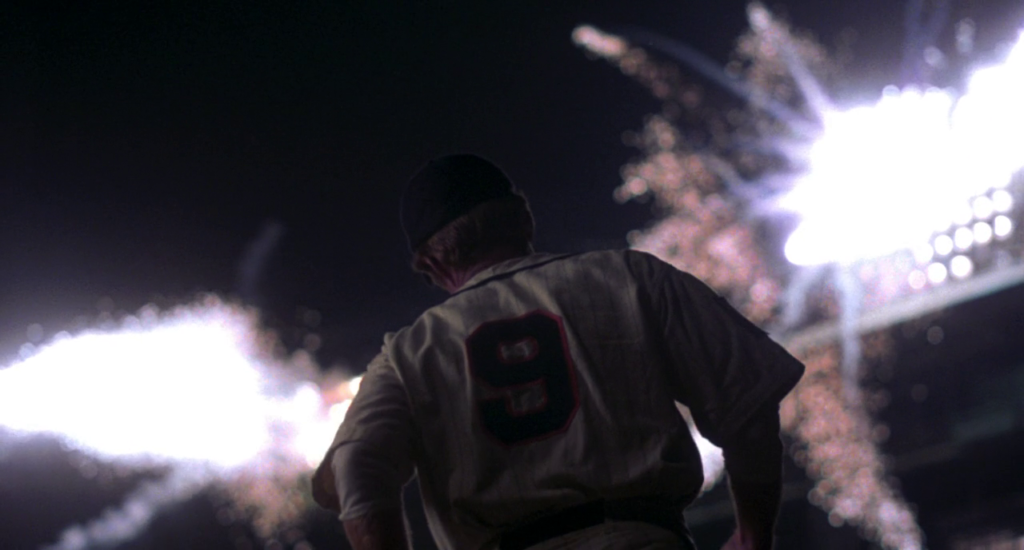
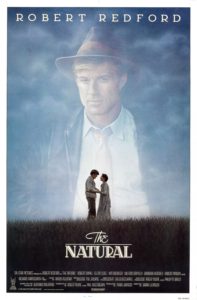 “Sports Beat”; September 29th 1939, MAX MERCY (Robert Duvall) reporting…
“Sports Beat”; September 29th 1939, MAX MERCY (Robert Duvall) reporting…
[pencil-sketched cartoon of an emptied New York Knights Field, with left-fielder ROY HOBBS (Robert Redford) rounding the bases, alone, amidst an effulgent glory of sparks and exploding lights. Caption reads: “Leaving teammates (and fans) in the lurch.”]
The New York Knights clinched the National League Pennant Tuesday evening due to a lucky combination of precision hitting and faulty wiring. In effect, a dramatic display of pyrotechnics rivaling such now-legendary feats as a jocose japester shattering the scoreboard clock at Wrigley Field and that same schmo needlessly knocking the cover off an unoffending ball.
Yes, fans, left-fielder and powerhouse hitter Roy Hobbs, in his final appearance as a New York Knight, certainly continues an unbroken streak of limelight attention-grabbing: score one for Hobbs and General Managers POP FISHER (Wilfrid Brimley) and RED BLOW (Richard Farnsworth); score zero for the Knights fans and teammates who will be looking forward to yet another losing season in 1940. As the smoke and dust clears at Knights Field this morning, the talk isn’t about baseball, but about the shards of a broken bat lying between Home and First Base called WONDERBOY.
Pardon, fans, while this reporter gags ever-so-slightly.
So just what has Hobbs done for baseball this past year? Their loss in the Series starting next week is a foregone conclusion (the headline, two Sundays hence, will read: “Bronx Bombers Sweep Knights in 4 Straight”), and by then certain revelations will come to light in a Sports Beat exclusive series this reporter is calling “Hobbs’ Mysterious Past”:
Sex! Scandal! Murder! Read all about a rumpot scout for the Cubs (John Finnegan) discovering a 19-year-old pitching prodigy in Nowheresville, USA. Read all about how this young phenom struck out THE WHAMMER himself (Joe Don Baker) at a carnie fair back in ’23. Read all about a darkling dame (Barbara Hershey) luring the impetuous youth to her hotel room and the gutshot wound that sidetracked a promising career for 16 years of prolonged hospital stays, Depression rail-riding, and Triple-A Ball.
There are no real Heroes, fans, only Showboats & Charlatans. And this Knight, this reporter should add, is certainly not Untarnished. Look for it, here, in your next issue of Sports Beat with Max Mercy!
…
So yeah, if you’ve ever seen this one—and who hasn’t?—you’ll probably recognize the plot sketch above, courtesy of oily sportswriter Max Mercy, as so much Sour Grapes. And really, if you like ‘em sour, then this one–Barry Levinson’s mid-eighties baseball-as-mythmaking classic THE NATURAL–probably isn’t for you. Slow motion! Sweeping majestic music! Yep, the rise-and-fall & fall-and-rise of a Great American Baseball Hero—followed by rising & rising & rising to a Triumphant! Super-Colossal! CLIMACTIC FIREWORKS DISPLAY!! (see above)—is perhaps the most shamelessly-manipulative, underdogging, come-from-behind sports tale ever committed to film.
To me, though, it works. Robert Redford is his usual craggily handsome, unassumingly heroic self—channeling a bit more Gary Cooper than might usually suit an aging glamour matinee idol—and is ably-abetted by cinematographer Caleb Deschanel’s Olympian-scale images and composer Randy Newman’s Aaron Copland-inflected score, bringing the baseball triumphs of this Joe Jackson/Babe Ruth/Joe DiMaggio-inspired, earthbound sportsgod to an almost Mythic Significance.
…

Joltin’ Joe – Left and gone away?
The film as a whole tends to remind me of a lyric from the 1968 hit single “Mrs. Robinson” by Simon & Garfunkel (an early version of which was featured in the 1967 film, The Graduate) which goes, “Where have you gone, Joe Dimaggio?/A nation turns its lonely eyes to you.” DiMaggio himself was reportedly peeved at the reference following the release of the song, but after songwriter Paul Simon actually met with The Yankee Clipper and explained, first, that no disrespect was intended, and second, that in an era of media-besmirched celebrities, there was a considerable shortage of true heroes in the late ’60s, DiMaggio relented and fully-endorsed his ‘appearance’ in the song.
If at all familiar with the classic work of literature on which this film is based, 1952’s The Natural by Bernard Malamud, you’ll know that Roy Hobbs actually strikes out in the end. Here, though, he definitely, um, *does not* (see above), changing the entire meaning of the work from a scathing satire on the perils & pitfalls of hero-worship to an unbridled celebration of baseball, honor, decency, and—I dunno—maybe even The American Way. (I can just hear the ‘pitch’ for this movie back in the early eighties: “Like Superman! Only he’s a baseball player!”)
As a kid growing up in the late ’80s, when the movie was continuously re-run on network TV, it was comforting to think that *maybe* there was this magical time in the remote past where champion sports players were actually decent, unassuming folks more concerned about the game and setting an example for their young fans as opposed to maintaining lavish lifestyles through their multimillion-dollar salaries! Yeah, it’s all quite over-the-top but, in its way, kinda wonderful…
Goofy glory, again, but still, it works: we need our heroes, don’t we?
III. EIGHT MEN OUT
(1988, Orion Pictures, dir. John Sayles)
“I may be dumb, fellas, but I ain’t stupid.”
“What can I say? People are human.”
“Say it ain’t so, Joe. Say it ain’t so.”
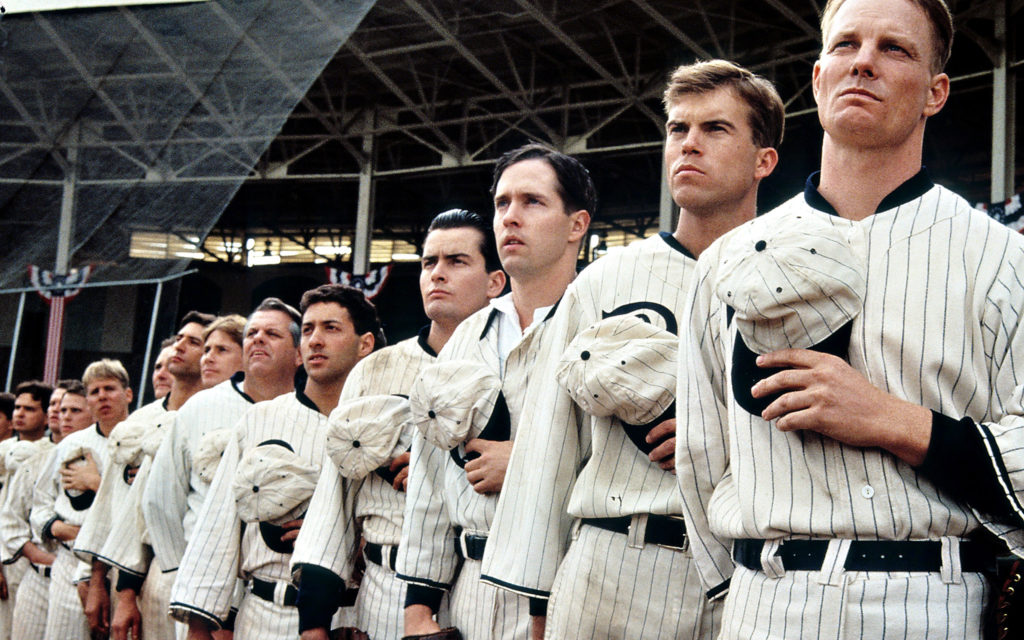
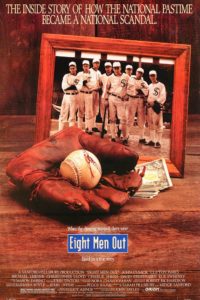 “Chicago Examiner”; September 30th 1919, HUGH FULLERTON (Studs Terkel) reporting…
“Chicago Examiner”; September 30th 1919, HUGH FULLERTON (Studs Terkel) reporting…
The 1919 White Sox season has been a wonder to behold as the greatest line-up ever assembled around the diamond—lead by pitcher EDDIE CICOTTE (David Strathairn), second baseman EDDIE COLLINS (Bill Irwin), and outfielder JOE JACKSON (D.B. Sweeney)—steamrolled its way to the American League Pennant in Cicotte’s 5-0 shutout against the Tigers. On to the Big Play! ‘19’s “best of 9” Series against the Cincinnati Reds starts tomorrow at Redland Park, being brought back home to Chicago on the 3rd with Mr. COMISKEY (Clifton James) hosting. Hope ol’ Commy has squared things with The Boys by then as this reporter got wind of their Big Bonus for the best season of play in baseball history: a dozen bottles of flat champagne!
“Chicago Tribune”; October 1st 1919, RING LARDNER (John Sayles) reporting…
Cicotte’s blow-up in the 4th resulted in a 1-9 loss for the Sox at Redland Park this afternoon. Commencing this singularly poor showing, this reporter witnessed cool-headed manager KID GLEASON (John Mahoney) himself throw his hat down in disgust after Cicotte beaned the Reds’ lead-off hitter square in the back. Over at The Examiner, Hughie’s insinuations of less than above board-play seem pretty hard to ignore after witnessing today’s comic cavalcade of fumbling, stumbling, and bumbling as The Boys prat-falled through 9 error-ridden innings. Get it together, Boys, and prove to all the naysayers that baseball is still the cleanest game in town!
“Chicago Examiner”; October 10th 1919, HUGH FULLERTON reporting…
Hopes for a late Series rally by the Sox were expunged yesterday afternoon at Comiskey Park when the Reds took ‘em by 5 following a prolonged farce of “highly suspicious plays”–which has become a veritable by-phrase for this shameful Series. In tribute to my esteemed colleague, Mr. Lardner, this reporter feels the need to take all the gangsters, slick operators, and greedy ballplayers to task for “Forever Blowing Ballgames.” Look for it, here, beginning in next week’s series entitled, “Is Big League Baseball Being Run for Gamblers, with Ballplayers in the Deal?”
“Chicago Examiner”; October 15th 1919, RING LARDER reporting…
After a late evening jaunt across The Park to, ahem, ‘examine’ galley-proofs for Hughie’s exposé on Black Sox shenanigans, this reporter finds the only appropriate response is to encourage with the same vigor with which one might direct towards a filth-encrusted intruder besmirching one’s hearth and home: Sic ‘Em, Boy.
…
Following his historical evisceration of an intense labor dispute in 1987’s Matewan (profiled on Labor Day), director John Sayles turned his attention to baseball and the Black Sox scandal of 1919. Based on Eliot Asinof’s 1963 book, 8 Men Out, the controversies and legends surrounding the most infamous sporting scandal in American history are laid bare, with much of the ‘blame,’ if it can be so-termed, put squarely at the feet of the team’s owner, Charles Comiskey, who refused to pay his championship team “a living wage.” Here, the only clear victor is high-rolling gambler and gang-leader Arnold Rothstein (Michael Lerner), who played the players, the hustlers, the reporters, and the fans for the “chumps and suckers” they most clearly were. Score one for the gangsters and big business, and a shutout for the rest!
Again, Sayles’ eye and ear for time and place is unerring as the Big City Baseball scene of the late teens is effortlessly revived by Robert Richardson’s vivid cinematography—a stark contrast to Haskell Wexler’s grimy, sepia-toned images for Matewan—and production designer Nora Chavooshian’s canny use of location space to create the peanuts & popcorn “jay atmosphere” of old-time Stadiums. (Yep, you can just feel the wood benches giving you an arse-full of splinters.)
…
Much of the pleasure of this movie comes from watching and listening to the conversation and interactions between the period-clothed, slang-speaking “characters”—again, straw-hatted reporters, three-piece suited gamblers, bow-tie wearing slicksters—who populate this fully-realized window into the past. In this vein, also of note is how then(1988)-young Hollywood Brat Packers like John Cusack and Charlie Sheen (playing shortstop Buck Weaver and outfielder Happy Felsch) are seamlessly transformed into street-tough, grizzled ballplayers of yore as opposed to a callow band of feckless actors who smirked their way through an endless procession of bad teen sex comedies in the eighties… And in a particularly ‘close-to-home’ casting coup, director John Sayles portrays his near-historical double, the famously witty and acerbic sportswriter, Ring Lardner!
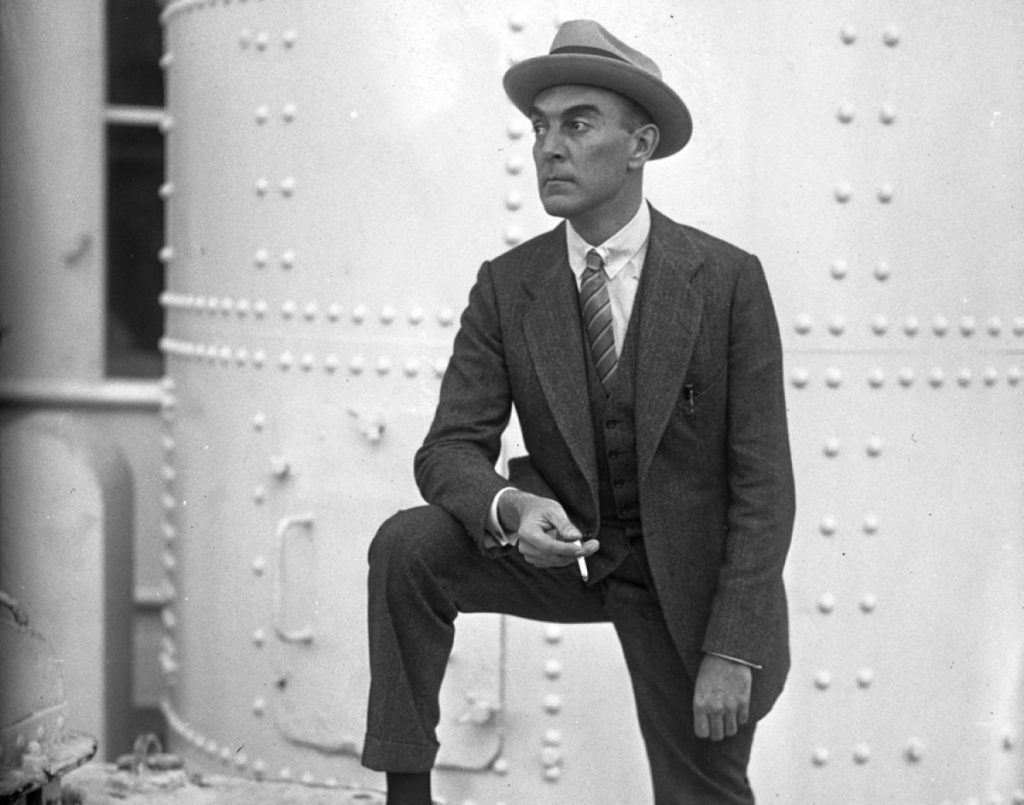
legendary sportswriter, Ring Lardner
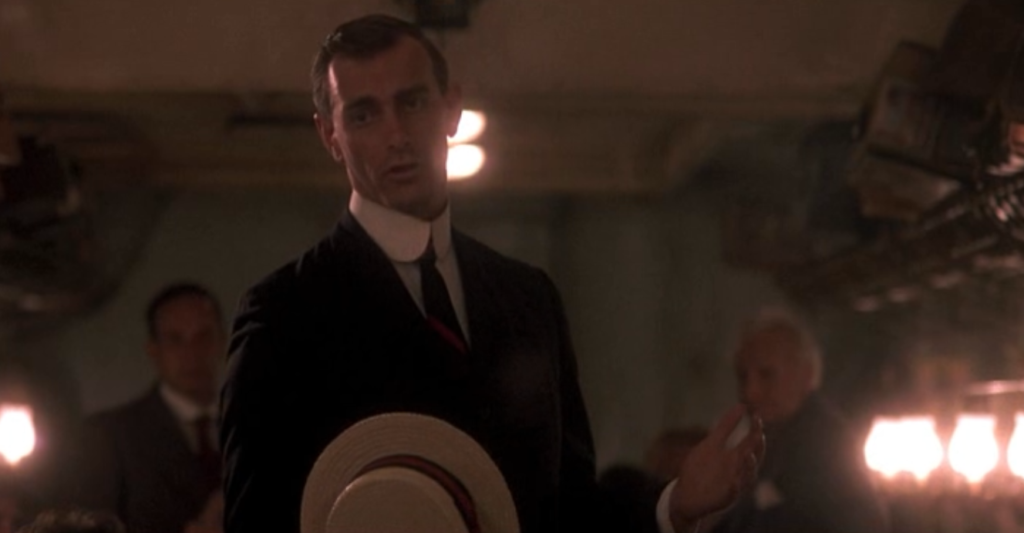
Director John Sayles as Lardner–Uncanny, ain’t it?
By all rights, considering my previous two somewhat saccharine selections, I probably should have chosen 1989’s supernatural tearjerker Field of Dreams to occupy this space. And while I do love that movie (what American male doesn’t tear up when he hears, “Hey, Dad? You wanna have a catch?”) I believe reality must trump sentiment this time out. As the “other movie” featuring Shoeless Joe Jackson released in the Fall/Winter of 1988/89, I have to say that that unfortunate sports hero is much more effective as he actually was: an illiterate son of a Southern sharecropper way over his head in the big city, rather than a ghost spouting cryptic wisdom in an Iowa cornfield. Not to take anything away from the latter version, but if you really want to understand the intersection between big business, entertainment, and exploitation in American history (‘cos that’s what it’s really about, Jack) consider the fate of poor Shoeless Joe!
Baseball, history, period clothes, old-timey slang; yep, my kinda movie.
IV. THE SANDLOT
(1993, Island World/20th Century Fox, dir. David Mickey Evans)
“You’re killing me Smalls!”
“You play ball like a girl!”
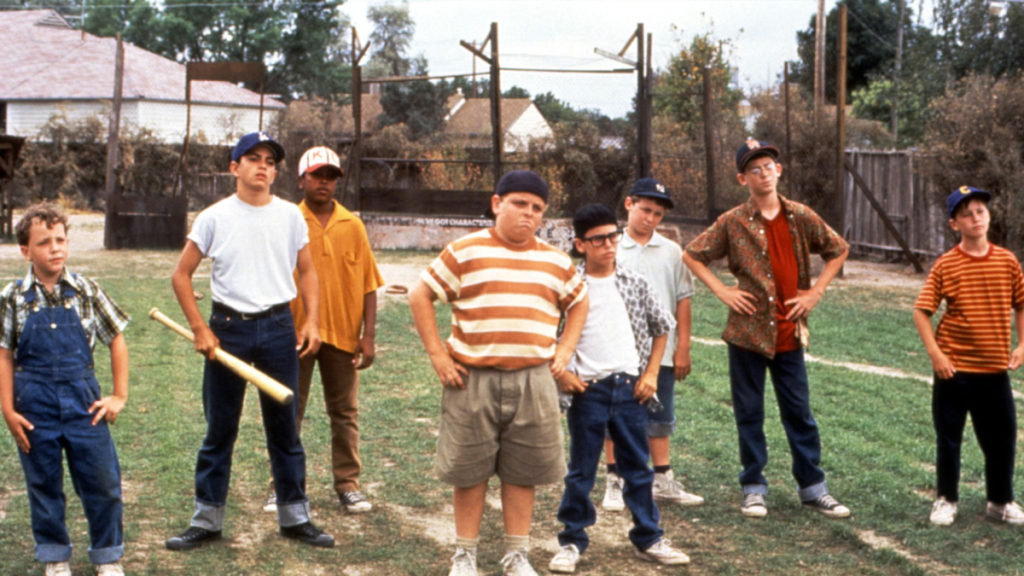
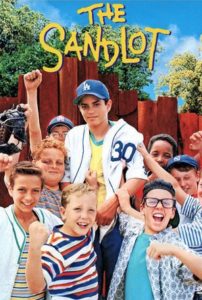 New York Knights Announcer SCOTTY SMALLS (Tom Guitry/Arliss Howard) writing for September/October issue of SportsBeat Magazine…
New York Knights Announcer SCOTTY SMALLS (Tom Guitry/Arliss Howard) writing for September/October issue of SportsBeat Magazine…
“BENNY THE JET: Baseball’s Magical Miracle Man”
Benjamin Franklin Rodriguez, known to thousands of adoring fans as THE JET (Mike Vitar/Pablo Vitar), ended his unparalleled 40 year career as a Major Leaguer, the last 15 spent as player-manager of the New York Knights, in Friday afternoon/evening’s doubleheader against the Bronx Bombers. (Need I mention the Knights blanked ‘em in both showings?)
In typically unassuming modesty, Benny, batting-in loaded bases at the bottom of the ninth, simply waved his cap at the roaring crowd, quietly passing beneath the stands that witnessed 2,322 consecutively-played games, 4,257 hits, 763 home runs, and a career batting average of .367. His valedictory baseball miracle performed, THE JET departed Knights Stadium as the best there ever was in this game.
LOU GEHRIG, TY COBB, SHOELESS JOE, HANK AARON, and the Sultan of Swat, the King of Crash, the Colossus of Clout, the Great Bambino, BABE RUTH himself: Yeah, they were all *pretty* good, I guess, but for this commentator’s money, no one beats THE JET. He is, was, and always will be Baseball’s Magical Miracle Man.
…
Mid-80s to mid-90s witnessed a leftfield revival of cinematic interest in sports movies: especially, and appropriately, baseball movies. I suppose one could come up with all sorts of reasons to explain this, and ultimately not come up with a single compelling or even convincing one, but the fact remains that following the mythic sweep and epic grandeur of 1984’s The Natural nearly every major studio in Hollywood clamored to jump on the baseball bandwagon. A brief inventory, dates excluded, and totally off the top of my head: The Slugger’s Wife, Bull Durham, Field of Dreams, Major League, Mr. Destiny, Mr. Baseball, The Babe, Talent for the Game, A League of their Own, Cobb… and all capped by Ken Burns’ massive 18+ hour PBS documentary on the history of the sport, simply entitled Baseball.
Out of this movie madness for all things baseball arose an interesting sub-genre of family-friendly sports movies aimed squarely at kids: there was Rookie of the Year (1993), about a kid who breaks his arm and develops a magical throwing ability, improbably-but-amusingly becoming a major league pitcher; Little Big League (1994), about a kid who inherits a losing major league baseball team and turns them into a winning one; and Angels in the Outfield (1994), about a major league team that receives divine assistance in answer to a little boys’ prayers from a choir of baseball-enthusiast angels. (yeah…)
Sure, these were all fantasies, but they were all nonetheless pretty darned entertaining and buoyed considerably by the naturally cinematic appeal of the sport: the wide-open arena like spaces of the diamond and outfield, the tension-filled ball-strike & foulball-ritual of a pitcher facing down the hitter, the effortless camaraderie of the sport and its players, and of course the intrinsic drama of ragtag players and teams coming from behind, both on and off the field, and wresting victory from the jaws of defeat! Good solid kids’ movie material, and I probably ended up taking my then-elementary school age little brother—I was in high school at the time—to all or most of ‘em.
…

Rollie Fingers… and mustache
But there’s one my brother Alex and I unaccountably missed, and that’s the one I’m (finally) getting to here today: 1993’s The Sandlot. If I had to pick a couple influences, I’d probably settle on the mid-70s foulmouthed baseball kids’ comedy The Bad News Bears (1976) by way of the coming of age period classic, Stand By Me (1986), but The Sandlot isn’t at all reduced by comparison.
Yeah, it’s about kids and growing up, but more than that it’s this absolutely realistic and hilarious account of what one does when one is 12—too old for tinker toys and too young for a job (or girls, for that matter)—and trapped in a small planned suburban community with an entire season’s worth of lazy summer days to spend: why, you band together with a buncha other kids and play ball. (In fact, that was exactly what I was doing one lazy summer when I first heard—courtesy of my sister shouting it out from the top of the park at the top of her lungs—that Alex, the little brother I mentioned above, had been born… and of course that he WAS a little brother and not a little sister!)
From the neighborhood’s magical “empty lot” to the legends surrounding a mythical chained beast; from figuring out what a “s’more” is to ill-advised misadventurous “romance” at the public pool; from one-upping a long list of sparring invectives to winning said contest by comparing one’s opponent’s playing style to that of “a girl”; from barfing on a carnie tilt-a-wheel to playing a night game backlit by fireworks; from a near-fatal lesson on who the heck The Babe was to, ultimately, being a kid on the outside magically ushered “in”… The Sandlot gets everything about those restless ‘tween years so gloriously right and, as such, has now earned the distinction, such as it is, of being one of my very favorite movies about kids, growing up, and baseball. One of those rare movies, presumably, I could watch over and over (and over) again without it getting boring or old…
So then, Alex, how in heck did we ever miss this one?
Play Ball

